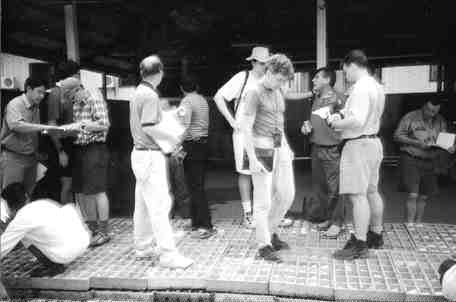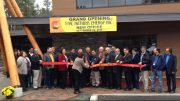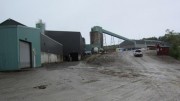In this, the conclusion of a 2-part report, the author examines additional warning signs, or “red flags,” which supposedly should have been obvious to those involved in the Busang project in Indonesia. He also contrasts these with “green flags,” including indications of mineralization.
The first article outlined the scope of work for a project review by MRDI, one of North America’s best-known and respected minerals auditing groups (see “Some new perspectives on Busang’s red flags” in T.N.M., May 27-June 2/02). This extensive and detailed review was commissioned in October 1996 to assess the work of Bre-X Minerals at Busang.
n The MRDI review: critical or complimentary? — MRDI’s team of four reviewers included one of North America’s most highly regarded gold resource evaluators and geostatisticians, one of the world’s experts on the sampling of coarse gold and a lecturer in fatal flaw audits, a geochemist experienced in quality assurance, and a geostatistician and economic geologist who was also experienced in resource and reserve audits.
In 1997, members of the MRDI team had presented a public course that included a discussion of how to check for fraud. It would be difficult to find a more appropriate or better-qualified consulting group to provide an independent opinion concerning the veracity of a project. Senior Bre-X staff based in Indonesia would be unlikely to allow, let alone invite, such a group to undertake a detailed review if they were involved in fraudulent or unprofessional activities.
MRDI’s summary of the Bre-X work said “the work Bre-X has done at Busang . . . is of a high industry standard. The regional and local geological setting, ore occurrence model, and interpretations are well-founded on detailed geological investigation, sampling and research, and provide a solid framework for the ultimate development of a world-class project.” More specifically, MRDI described the core-logging procedures at Busang as “excellent, providing highly detailed and informative geological and geotechnical logs of all drill core.”
n MRDI’s recommendations — The auditing group addressed several issues, none of which was likely to be a project-killer. Its recommendations relate to areas that are relevant to many mineral projects. Curiously, the commentators who have referred to the MRDI report have generally passed over its complimentary remarks, whereas readers of the report cannot help but notice its overwhelmingly positive tone.
n Use of reputable and experienced independent consultants — Kilborn Pakar Rekayasa undertook the prefeasibility study, issued in March 1996, and the intermediate feasibility study, issued in October 1996. These studies included resource estimation. Normet, an Australian metallurgical and engineering company, managed the metallurgical tests undertaken by an associated company, Oretest. Normet and Kilborn, both of which had considerable experience with gold projects in Indonesia, including Kelian, worked closely together and reviewed each other’s work. Some metallurgical work was also contracted to two U.S. companies, Hazen Research and A.R. MacPherson Consultants. Hundreds of years of professional experience were represented by these firms, and no irregularities were reported.
The pilot plant trial was conducted at AMDEL, a well-known Australian minerals testing laboratory, and petrology and mineralogy were sub-contracted to three different petrologists. In addition to these, Hazen used its own internal mineralogical specialist to examine gold grains from its gravity concentrates. Gold grains from the pilot plant trial were also examined at AMDEL.
Bre-X chose a group of highly regarded consultants who were uniquely qualified to identify any irregularities in the gold mineralogy or gravity processing results. All the consultants were independent of Bre-X, and all the metallurgical groups had considerable experience in gravity concentration of gold.
n Gravity test results: incompatible with hard-rock gold mineralization? — Gravity concentration separates lighter minerals from heavier minerals, such as sulphides and gold. The gold in a heavy mineral concentrate may be “free” or, for example, closely associated with other minerals, such as sulphides, in such a way that it is not free. The addition of mercury to gravity concentrates has long been the standard method of distinguishing free gold from that which is closely associated with other minerals. This process (whereby gold combines with, or attaches to, mercury as a result of its physical nature) is known as “amalgamation.” The amount of free gold is determined by recovering the gold from the mercury.
Gold in a gravity concentrate that is associated or intergrown with sulphides and other minerals will not amalgamate with mercury, resulting in a low amount of amalgamable gold. In most circumstances, “free gold”, such as alluvial gold, is readily amalgamable with mercury.
Coarse alluvial gold that had been sprinkled into bags of drill core should easily be detected by gravity separation into a heavy mineral concentrate followed by amalgamation with mercury.
The amount of free gold in drill-core from the Central zone was determined in amalgamation tests as part of the 1996 prefeasibility metallurgical studies. These tests for free gold were the only ones ever performed on Busang samples. Gold was reported in these studies as being largely unrecoverable by amalgamation.
The amount of free gold (as a proportion to the total gold) of samples from the three “primary” ore types was determined to be 10%, 13% and 20%. In contrast, the “oxide” sample had a higher amount of free gold (80%), which was to be expected. Oxidation is known to promote the development of free gold with many oxidized ores having higher metallurgical recoveries than primary (“sulphidic”) ores.
All these results are consistent with those expected for the mineralization types. The results are incompatible with the presence of salted coarse alluvial “free” gold. They therefore constitute large green flags, to which the critics never referred.
n The gravity test results: too good to be true? — The gravity recovery results from Busang were achieved from laboratory testwork using Knelson concentrators. Commentators have compared Busang’s high (80% and higher) gravity recoveries achieved from laboratory tests to recoveries achieved in actual mining operations. They have suggested that the recoveries from Busang were unbelievable or at least suspicious.
It is a fundamental notion in science that “apples be compared with apples.” The expectation that recoveries from carefully controlled gravity tests performed in the lab under ideal conditions would match those from actual operating plants is a belief against which metallurgists warn. In fact, the relationship of the gravity recoveries, as determined in the lab, to actual mine operating plant recoveries is an active area of research. In actual mining operations, as little as 20% of the predicted laboratory-based gravity recoveries and as much as 90% may be achieved.
It is unreasonable to use gravity recoveries from actual operations to characterize the Busang laboratory-based tests as being suspiciously anomalous. One mine in Australia had a predicted gravity recovery of more than 90% on the basis of laboratory testwork. Once in operation, the mine proceeded to recover only 20-30% of the gold using gravity methods.
There are numerous examples of lab tests giving gravity recoveries of greater than 80%. The lab-based gravity recoveries from Busang were not extraordinary and, as such, did not attract any questioning comments by the three groups of metallurgical consultants who reported, and commented on, the results.
n Did the gravity pilot-plant results confirm the high gravity recoveries? — A 27-tonne sample of Southeast zone mineralization consisting of 11,700 metres of drill core from eight lines of drill holes was processed in a pilot gravity plant at AMDEL in South Australia. Pilot-plant trials are not normally undertaken for gold projects. The trial demonstrated a commitment to rigo
rous testing over and above most gold projects. Pilot plant results are universally regarded as being better indicators of actual plant performance than standard laboratory batch tests based on smaller samples (often less than 5 kg). Such trials would normally attract positive comments from commentators and reviewers.
The pilot plant trial resulted in a gravity recovery of 49%. Kilborn used this result, in what turned out to be the final monthly report of the project, to predict that about half of the gold could be recovered by gravity. Using the criteria of the critics, this clearly is incompatible with the gold being of coarse alluvial origin. It is, however, compatible with hard-rock mineralization. Commentators have not mentioned these pilot-plant results and their significance.
n Was there any evidence for surface depletion? — Observers have pointed to the discrepancy between the positive gold response in soils over the Central zone, compared with the negative gold results from surface samples from the Southeast zone, as demonstrating that there was no gold in the Southeast zone.
The existence of a gold depletion zone in weathered outcrop over the Southeast zone (there are no soil samples over that zone) stood in contrast to anomalous gold concentrations in soils and weathered outcrop over the Central zone. The difference between the two areas was explained as having resulted from the longer time of weathering and leaching in the Southeast zone, as compared with the Central zone, and that this duration was due to the existence of a protective cap of sediments that outcrops over the topographically higher Central zone.
The low gold over the Southeast zone was inconsistent with the author’s experience in similar environments, though similar near-surface gold depletion had been experienced by some of the Bre-X geologists prior to their work at Busang. The Mirah prospect, also in Kalimantan, shows this feature (van Leeuwen, 1994, p. 73): “Vertical zonation of metal grades shows a near surface depletion of gold and silver with enrichment of gold and silver at depths of 18-25 metres.”
Based on the Bre-X geologists’ immediate past experience, Mirah was logically used as a model for the near-surface gold behaviour in the Southeast zone. But was there any support in the drill hole assays for the depletion over the Southeast zone and a lack of depletion over the Central zone?
The author has reviewed the drill-hole grades and found a marked difference between the two zones’ near-surface gold results. The Central zone shows variable gold grades averaging between 1.7 and 3 grams per tonne from surface to a depth of 25 metres. In complete contrast, drill-hole gold grades in the Southeast zone show a steady depletion of gold from 2.5 grams per tonne at 20-25 metres below surface to less than 1 gram per tonne at surface. The drill-hole assays plausibly support the depletion of gold at the surface in the Southeast zone.
The gold tampering, therefore, was successful in achieving two outcomes: first, the gold grades closely matched the geology; second, there was remarkable steady depletion of gold grades toward the surface in the Southeast zone in a way that was generally consistent with the surface results.
n Prospective geological environment — Details of the large magmatic-related hydrothermal system at Busang have recently been published, and stated to be comparable to, many similar occurrences elsewhere in the Pacific region (Leach, 2001). The system evolved from early-stage porphyry quartz-molybdenite veining to phyllic alteration to carbonate-base metal veining and finally to an epithermal-style event. As stated by Farquharson, et al. (1997, page 51):
“The Busang geologic setting is such that there is no doubt that it represents a valid exploration target for gold. . . . Discussions with the consulting geologists Greg Corbett and Terry Leach, brought to the Busang site at the time of our visit by John Felderhof and who have an excellent background in the geologic environment of settings such as Busang, confirm the highly prospective nature of the geology.”
n More green flags — Examples of various green flags include: the experienced staff; the numerous positive comments from outsiders regarding the operation and procedures; the well-managed storage facility; the accurate logging; the core photography (described by an independent observer as “excellent”); extensive check-assaying; use of three assay labs; co-operation of staff with outside consultants; preparedness to drill three parallel and three scissor holes; and the detailed surface geological sections and plans.
n The lessons that Busang does not teach us — No amount of regulation, Canadian National Instruments, Australian JORC codes, Qualified or Competent Persons and ISO protocols will be able to prevent rare instances of determined and intelligently planned fraud. We cannot conduct our lives, businesses and industry on the basis of total mistrust in our colleagues. There have been various responses to Busang resulting in the call for all sorts of new protocols and precautions, but how can these be assessed and appropriately analysed when the accounts of what happened are so flawed?
The assumption that the Busang tampering was something that should have been obvious to the engineers, geologists and metallurgists involved in the project has done the Canadian mining and exploration industry a gross disservice. Furthermore, by virtue of a rich tradition of scams, blunders and exaggerated claims, mining industry spokesmen from Australia are in no position to criticize their Canadian colleagues.
The focus of the past five years on the supposed “red flags” and the neglect of the positive results or “green flags” have prevented a meaningful and informed discussion about what actually happened. The vociferous criticism only came after the event. The scale and accuracy of the fraud may well have duped me, the readers of The Northern Miner and maybe even Strathcona Mineral Services.
References:
Cottle, J.W. and Parker, H.M., 1996: Mineral Resources Development Inc. (MRDI), 1996: Busang Project Review — Final Report. December 1996.
Farquharson, G., Thalenhorst, H. and Von Guttenberg, R., 1997: Busang Project — Technical Audit for Bre-X Minerals Ltd. Strathcona Mineral Services Ltd., Toronto, Canada. Interim Report.
Forensic Investigative Associates, 1997: FIA Interim Report of Investigation into Tampering with Bre-X Minerals Ltd. Busang Core Samples.
Leach, T.M., 2001: Alteration and Mineralization in Drill Core from the Busang Prospect, East Kalimantan, Indonesia. Indonesian Mining Conference and Exhibition, 2001, Jakarta.
Van Leeuwen, T.M., 1994: “25 Years of Mineral Exploration and Discovery in Indonesia.” Journal of Geochemical Exploration, vol. 50, pp. 13-90.
— The author is a principal of geological consulting firm Hellman & Schofield, in Eastwood, N.S.W., Australia. He has been retained by lawyers acting for the defence of John Felderhof, Bre-X’s former general manager in Indonesia. He can be reached by e-mail at plh@hellscho.com.au




Be the first to comment on "Commentary: Busang criticisms led to distortion"